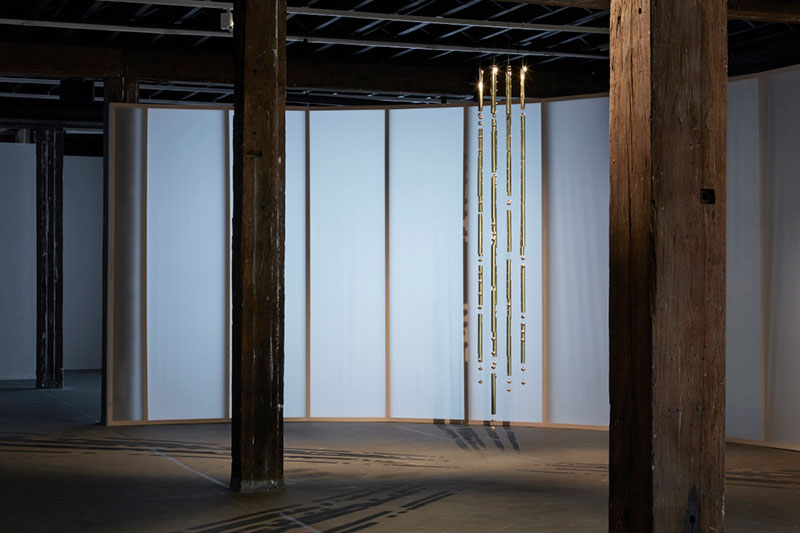
What are the messages we are sending?
Relay League Angelica Mesiti
Unmarked sequences of translucent parchment membranes insinuate themselves through Sydney’s Artspace. The architectonic scale and rhythmic regularity of shape provide corporeal pathways and frames for Angelica Mesiti’s latest work, Relay League, a three-channel video installation with sculptural counterpoint. I am pleased that this complex, subtly provocative but ultimately romantic and uplifting work is about to embark on an extensive Australian tour.
Relay League shows once again that Angelica Mesiti is a bravura technician, and an Australian artist worthy of note. Since 2009 she has gained wide public and critical acclaim for her nuanced exploration of the landscapes of communication, examining in particular how sounds interact with the human body and how, from such reverberations, language as a field of echoes and mimicry is formed, maintained, disseminated and translated. This abiding interest springs perhaps from her childhood experiences at home in Sydney where several languages operated simultaneously. As well, Mesiti’s training as a dancer led to her focus on the Rudolf Laban technique, absorbing the idea of the body in motion as a body that creates a code, a script that can be written, read and followed. In earlier works she has paid homage to her mentors and influences – John Cage, Meredith Monk and especially the recently deceased Pauline Oliveros. In her work Angelica Mesiti asks us to consider the spectrum of languages. Her project, it seems, is how to represent the primordial desire of humans to communicate.
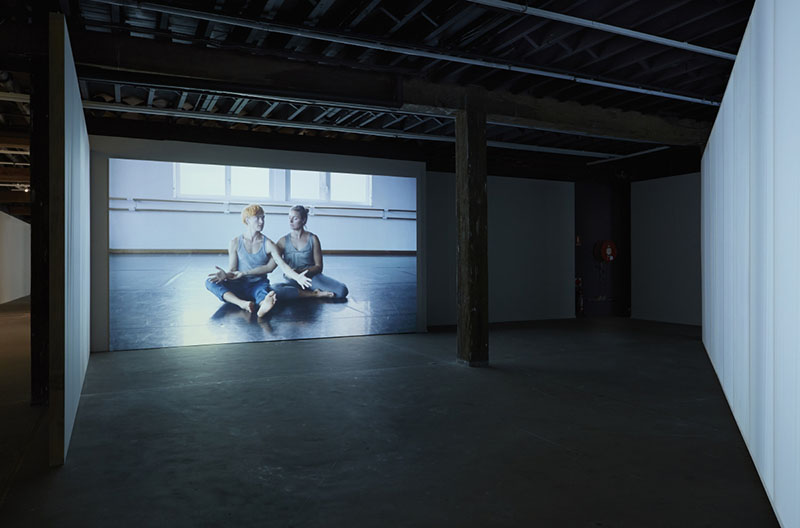
A key socio-political context for Relay League is the tsunami of mass communications we currently endure. There appears to be a perverse pleasure, exemplified by US President Trump, in our devotion to the Twittersphere, fake news and the compounding echo chambers that constitute the Age of FANG (Facebook, Amazon, Netflix & Google). Our concomitant obsession with photographic imagery feeds this mania through each new handheld device launched onto the market and the myriad of apps designed to augment data capture and signal our connectedness through what now constitutes the record of our memories. Amidst this torrent of moving talking photographs, Mesiti asks in her quiet way what are the messages we are sending and do other people understand them.
Ironically, Relay League emerges from the artist’s fascination with a quote from the philosopher–mathematician Blaise Pascal, “Calling all, this is our final cry before our eternal silence”, the last message transmitted in Morse code by the French Navy on 31 January 1997. I wonder which official decided on this memento mori to mark the end point of a language. Before radio waves and digitalisation there was only Morse code. Named after a struggling artist but canny entrepreneur Samuel F.B. Morse, instead of its true inventor, Morse’s contract worker Alfred Vail, Morse code is where short and long bursts of electrical energy are sent along wires that connect different locales. Vail and Morse were no doubt aware of Braille, the first binary code of the modern era that made each letter of the alphabet equivalent to a series of dots (short bursts) and dashes (longer bursts). From the late 1840s it became one of the great drivers of the Industrial Revolutions, to become the standard method of long-distance communication.
Supremely low tech, Morse code was the Esperanto before Esperanto – it shrunk the world to completely change the nature of commerce, the sciences, transport, diplomacy and war. Information, ideas all forms of communication was relayed around the world on telegraph wires and cables. In contrast, the then new rote- counting methods, sounds and odd syncopation of Morse code were an inspiration to Leah, Kate and Maggie Fox who in 1848 claimed to hear spirits inhabiting the walls of their down-at-heel Hydseville New York home. Their somewhat “Morse-ean” aural hallucinations helped create the Spiritualist movement. It is not insignificant, for Relay League, that the best Morse code operators likened their trade to solo musicians as they had to train their ears to pick up the rhythm of the faintest of signals – the “dits and dahs” as they were known in the business.
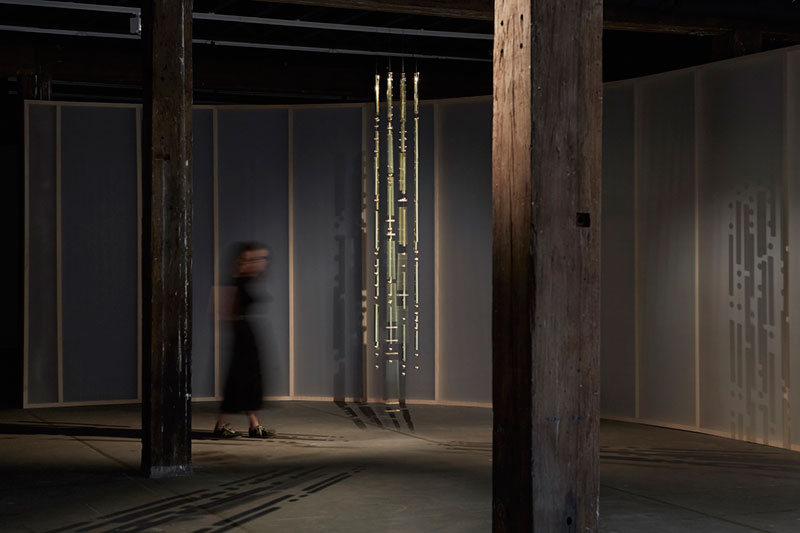
Mesiti gives the Pascal quote a three-dimensional representation – the sculptural counterpoint and centrepiece of the installation. At first glance, it looks like an imposing decorative waterfall of lozenges and balls; from certain angles, the shadows it casts are a reminder of more complex written texts. Its faux retro minimalism, its shiny rich surfaces are surprisingly sensual in an otherwise highly meditative, pulled-back environment. This particular golden shower is not a reference to the fun, mythological story of Zeus appearing to Danae. Rather, the sculpture is conceived to operate as a giant wind chime or bell. Mesiti would like audiences to physically interact with the work, to play and make sounds haptic acts of magical generation and broadcasting. A constant element in Mesiti’s work is this recognition that sounds can congeal into languages as shared codes.
This distant, vaguely anthropological and quasi-documentary tone of the video projections also works to represent life in the minor key. Audiences are witness to the often overlooked or rarely revealed processes and codes used in the development of dance performance work, the usually unspoken language of choreography. The three video projections depict improvised percussive sounds performed on a rooftop, a studio where an embodied translation of the soundscape by the choreographer is presented to two dancers; here, they sit cross-legged intent on memorising every aspect of pose, gesture and movement.

In Relay League there is an enormous range of information, ideas and sounds created, shared and translated by humans across different spaces and times. The visual elements are simple and easily digested – a limpid, uniform light reveals Mesiti’s collaborators, the drummer Uriel Barthélémi, dance master (my title) Felipe Lourenco and Dancers Sindri Runudde and Emilia Wibron Vesterlund. Committed artists all, it is important to note that they are also young, beautiful and exotic. It goes without saying that they are performing gendered codes of behaviour. The soundscape intrigues by its reiteration throughout the installation – a subtle osmotic bleeding through the aforementioned translucent membranes that divide and guide.
In one of the projections Mesiti gave instructions to Barthélémi to refer as close as possible to the sound of the code “Calling all, this is our final cry before our eternal silence.” As the improvised performance develops we see the artist extend the sonic potential of the drum kit with found objects, such as small flat brass bells and a seed pod from the Delonix regia (Poinciana) tree, a native of Madagascar. The problematic air of the postcolonial is hinted at again by the choice of location – the top of the Centre National national de la danse, a Brutalist building just near the Peripherique on the north-eastern edge of Paris. It is immediately striking that the vista does not look like a European city. Isolated in his eyrie, there is a certain majesty to Barthélémi’s vision, broadcasting his messages, to the world.
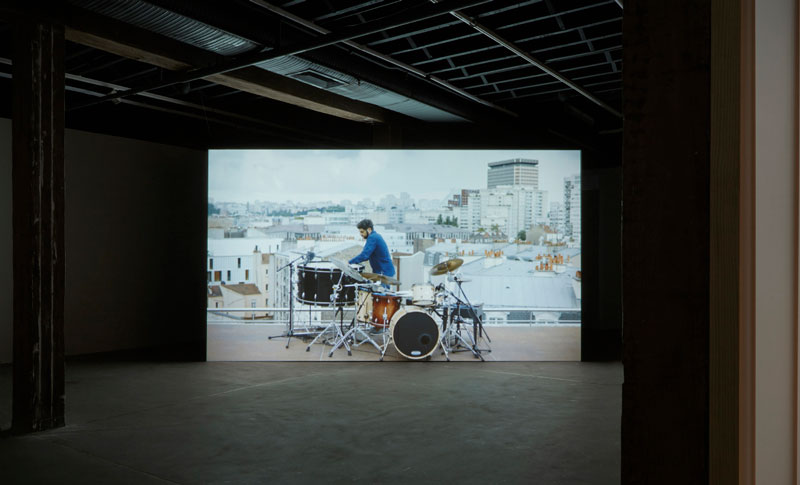
Modernist rejection of clear narratives, the quasi-therapeutic athletic primitivism of Pina Bausch, the magisterial Zen interiority of Butoh, are still strong energies within the histories of modern and contemporary dance performance and documentation. In Europe, North Africa and South America there is also a renewed interest in and salvaging of quickly disappearing folk traditions. The dance master/choreographer Filipe Lourenco draws on these contexts to present a strangely contained and constrained interpretation of the percussive soundscape. Mesiti’s sympathetic, distancing lens makes the creation of this new dance work fascinating. We see choreography as a knowledge system beyond the verbal[1] Bodies are a semiotic field – as physical images they provide the grammar syntax and vocabulary of this language. As signifiers of stasis, momentum, flow and space, they become talismanic symbols performed through Lourenco’s ritual engagement of his back arm and leg muscles. In this projection Mesiti creates an amusing mise en-scene as she slowly pans the camera away from Lourenco’s stately display to reveal the slightly hunched backs of a male and female simultaneously trying to memorise and make meaning of the choreographers actions.
In the third projection we encounter this entranced duo in close-up. Looking like they have just emerged from an Arthur Rackham fairytale illustration, what is immediately obvious about the pair is their extraordinary charisma and their wildly intimate modes of communication. They have what used to be called élan-vital. Emilia Wibron Vesterlund is sighted while Sindri Runudde has very limited vision. But, between them, the contexts of adversity do not exist. Surely, and partly the result of their shared experiences of repetitive arduous physical training, it is almost embarrassing but also wonderful to witness their rapport, their unique language. They both give and help each other to perceive and hopefully remember what is before them.
Here, Mesiti subtly represents Michael Tomasello’s most-persuasive arguments for the origins of language.[2] Put simply, language is a form of cooperative information exchange for humans in specific contexts and circumstances. It begins with close looking and hearing, mimicry and play, specifically pointing to and employing other physical gestures and vocalisations to direct the individual and collective gaze. It is when the sheer number of shared observations (bytes) amongst the group(s) become unwieldly that they are eventually given symbolic sonic form.
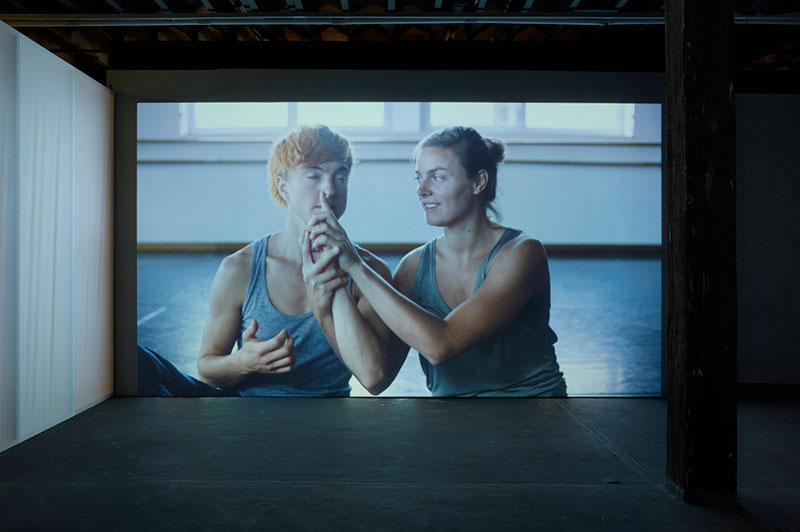
Rather than complete the narrative arc that audiences by nature construct while journeying through the installation, with footage of Emilia and Sindri mimicking or making a pantomime of the master’s instructions, Mesiti chooses to defer that possible pleasure. We are left with a poignant sense of the positive, purposeful human activity flourishing in a vast, shifting spectrum of languages and codes.
See this exhibition if you can. Relay League extends and enhances Angelica Mesiti’s leitmotif of human communication in a most sophisticated manner. Although it troubled Charles Darwin that humans have an excess of cooperativeness and reciprocity these qualities are the bedrock for the beginnings of language. What can be more romantic in the twenty-first century than connectedness? There is poetry in the theoretical possibility that we learnt to speak by listening to birds. This is at the heart of Relay League. In an altogether apocalyptic 2017, I very much like the idea of humans as a distinct and good species.
Footnotes













